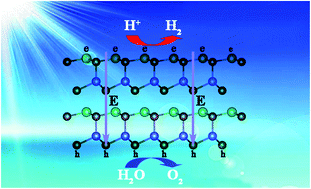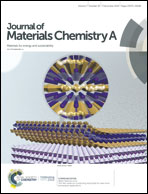Li-III-VI bilayers for efficient photocatalytic overall water splitting: the role of intrinsic electric field†
Abstract
Two-dimensional (2D) materials are highly promising for converting solar energy into valuable hydrogen fuels through photocatalytic water splitting. However, few single photocatalysts can intrinsically satisfy the requirements of high solar energy conversion efficiency and photocatalytic redox reactions. Using first-principles calculations, we propose the experimentally attainable 2D LiMX2 (M = Al, Ga, In; X = S, Se, Te) bilayers as ideal candidates to achieve this goal, taking advantage of the intrinsic electric field effect. They have direct band gaps, higher carrier mobility and a wide light absorption range, which are beneficial to the photocatalytic performance. The intrinsic electric field not only promotes the spatial separation of photogenerated carriers, but also contributes to high solar-to-hydrogen (STH) efficiency with an upper limit of 20.1–36.6%. Similar results have also been found for LiMX2 multilayers. More interestingly, the strong photocatalytic redox ability of the LiGaS2 bilayer makes the hydrogen evolution reaction (HER) and oxygen evolution reaction (OER) proceed, driven solely by the photogenerated electrons and holes in pure water (pH = 7). These results indicate that the LiMX2 bilayers could be utilized for efficient photocatalytic overall water splitting in pure water without the need for sacrificial reagents or cocatalysts.



 Please wait while we load your content...
Please wait while we load your content...